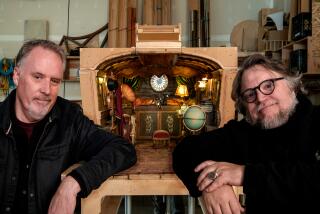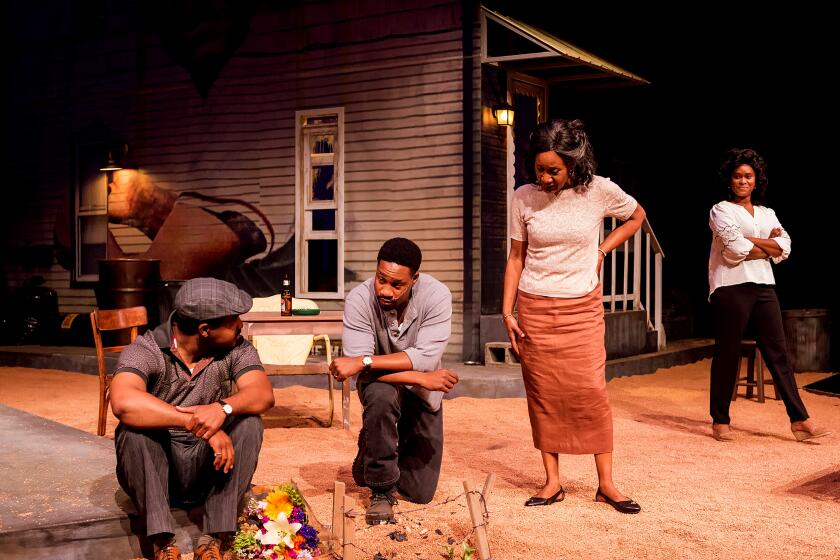This isn’t the Disney ‘The Little Mermaid’
John Neumeier doesn’t know “who started the rumor” that all children should avoid seeing his ballet “The Little Mermaid.” But he suspects that the culprits might be big fans of the exuberant 1989 animated Disney film that made the Hans Christian Andersen fairy tale synonymous with spunky, red-haired Ariel and the crab Sebastian singing “Under the Sea.”
“My ballet doesn’t have the sweet aftertaste of the Disney film, and there are moments of brutality,” the 70-year-old chief choreographer and artistic director of the Hamburg Ballet says by phone from his company’s headquarters in Germany.
“And the work isn’t for very young children. But I don’t believe that older children can’t understand cruelty, not in an age when they can turn on CNN and see the most horrible things.”
PHOTOS: Arts and culture in pictures by The Times
Commissioned in 2005 by the Royal Danish Ballet to celebrate Andersen’s 200th birthday, “The Little Mermaid” has subsequently both delighted and shocked audiences worldwide with its adult sophistication and fidelity to the original tale of brutal self-sacrifice and unrequited love. The ballet, which Neumeier revised for his company’s repertory in 2007, will receive its Southern California premiere when Hamburg Ballet visits Segerstrom Center for the Arts this week.
The ballet features a mermaid who gets her tail violently torn off by an evil Sea Witch. Consequently, she spends some of her time onstage in a wheelchair, doesn’t get to live happily ever after with her prince and through choreography that often looks deliberately uncoordinated and tortured tries her best to convey the emotional truth of Andersen’s story.
“Whenever I do anything, whether it’s Shakespeare or Ibsen, I want to get into the text itself, to understand what the emotional content is and then to find the dance movement that will convey this,” says Neumeier, a soft-spoken American who celebrates his 40th anniversary leading the Hamburg Ballet this year. “A ballet can never be the actual story, but it should be complex in its dramatic structure and emotionally inspired.”
Milwaukee-born Neumeier majored in English and theater studies at Wisconsin’s Marquette University. The expatriate choreographer has pursued a nearly lifelong devotion to creating his own genre of full-length, unabashedly theatrical story ballets in an era when so many of his peers took their cues from George Balanchine and that choreographer’s focus on purely abstract dance. This might explain why many of Neumeier’s works have received more critical acclaim abroad than in the United States.
“John’s work isn’t easy, but it is beautiful and there are always powerful emotions in whatever he choreographs,” says Segerstrom Executive Vice President Judy Morr, who considers the Hamburg Ballet “one of the great companies of the world.”
A dancer whose training included attending the Royal Ballet School in London, Neumeier performed with the Stuttgart Ballet for six years and found his home as a choreographer in 1973 with the Hamburg Ballet. Since then, he has produced an oeuvre in which the classics of Western literature and drama have played a pivotal role. This has included his adaptations of numerous Shakespeare plays, as well as Tennessee Williams’ “A Streetcar Named Desire,” the story of King Arthur, the biography of dancer Vaslav Nijinsky and Alexandre Dumas fils’ novel “The Lady of the Camellias.”
In all of his works, Neumeier seems intent on finding the right balance between taking artistic license and preserving a story’s original essence. In the case of “The Little Mermaid,” the lovesick Andersen becomes a character in the story, remembering the wedding of his friend Edvard. The Andersen character then sets the stage for the fantasy world of the Mermaid, which Neumeier conjures by introducing choreography, costumes and visual scenery that blend elements from a variety of traditional performance forms, including Japanese Noh theater and Balinese dance.
PHOTOS: Arts and culture in pictures by The Times
“I was trying to find in these early forms a way of translating a ballet dealing with different realms,” Neumeier says. “It’s very important that you create a complete world, that’s why I design my own costumes and lighting. I always have a strong intuition about how I want the world to look.”
“John is a master at storytelling and not in an old-fashioned way,” says Helgi Tomasson, artistic director of the San Francisco Ballet. His company performed “The Little Mermaid” in a 2010 U.S. premiere and for PBS’ “Great Performances” the following year and is available in full on the PBS website.
Tomasson, whose company will perform Neumeier’s “Nijinsky” this month, has been on a mission to present more of Neumeier’s work in the United States. “As a company, we do very few full-length story ballets, and John has this approach to storytelling where it’s all done through movement, where you don’t need pantomime or program notes to understand what’s going on and where there’s always this human quality, this emotional component,” he says.
Neumeier’s insistence on dramatic complexity in everything he creates means that his dancers, in addition to possessing the formidable technical abilities required in top ballet companies, also need to be actors capable of embodying the inner lives of the characters they portray.
The Mermaid character, for example, “is not a role to perform but to fully live,” says Silvia Azzoni, a principal dancer with the Hamburg Ballet who will perform the part in Costa Mesa. “You can’t just put on a mask and pretend to be a sea creature. You have to live inside her skin and [live] her determination, her loving, her suffering and her desperation.”
Ultimately, everything that Neumeier tries to accomplish in his ballets stems from his belief “that dance expresses the complete human being … the physical, spiritual, emotional and erotic. I’ve never been interested in just sport-related virtuosity, of who can jump higher or turn more,” he says. “For me, it’s about two people onstage reacting to each other. That for me is a drama.”
Having created 148 works for his company, Neumeier believes he’ll always be a kinetic storyteller. “I don’t think I’d ever retire, though there might be a time a few years from now when I might become a freelance choreographer,” he says. “But I’ve always had this interest in creation and not feeling that anything I do is really finished. I’m always continuing and developing a story.”
MORE
INTERACTIVE: Christopher Hawthorne’s On the Boulevards
VOTE: What’s the best version of ‘O Holy Night’?
PHOTOS: Arts and culture in pictures
More to Read
The biggest entertainment stories
Get our big stories about Hollywood, film, television, music, arts, culture and more right in your inbox as soon as they publish.
You may occasionally receive promotional content from the Los Angeles Times.






